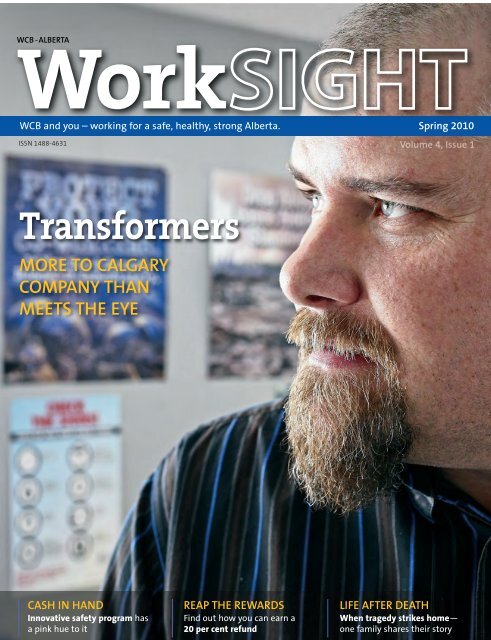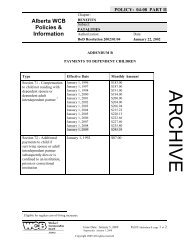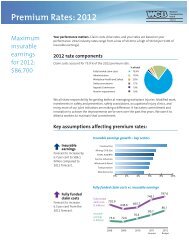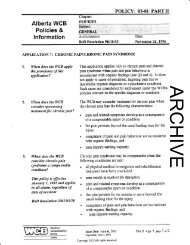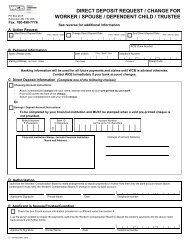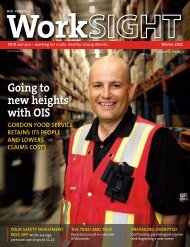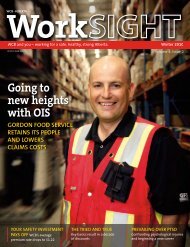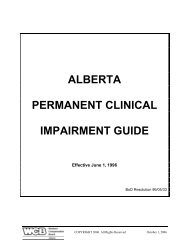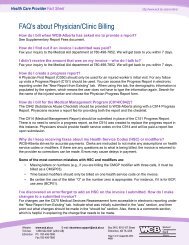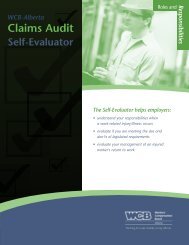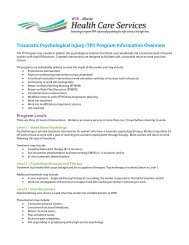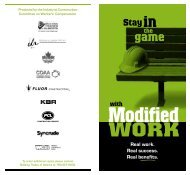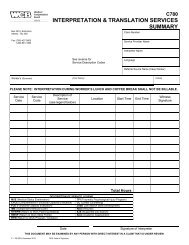WCB WorkSIGHT SPRING 2010 - Workers' Compensation Board
WCB WorkSIGHT SPRING 2010 - Workers' Compensation Board
WCB WorkSIGHT SPRING 2010 - Workers' Compensation Board
- No tags were found...
You also want an ePaper? Increase the reach of your titles
YUMPU automatically turns print PDFs into web optimized ePapers that Google loves.
PROVIDING SAFE ANDRELIABLE, QUALITYDOORS FOR OVER20 YEARS!For over 20 years, A-1 Power Doorhas been providing barrier freepower doors to businesses acrossWestern Canada. Through ourcommitment to complete customersatisfaction, our wide range ofproducts and our determination torst time, A-1 PowerDoor has become a national leaderin the automatic door industry.Along with our industry leadingautomatic door solutions, A-1 Powerers access control systemsand a wide range of specialty doorsand loading dock equipment.Stop by, or call us today!#6-1826 25 Ave NECalgary, ABT2K 7K1(403) 777-838310535 170th StEdmonton, ABT5P 4W2(780) 436-9300OUR DOORS ARE ALWAYS OPEN!Celebrating 20 years of opening doors to the future.
“We want to instil in all of our staff that the first thing theyshould be thinking about when they’re on the job is safety.”— Shawn Hennon board. We want to instil in all of our staffthat the first thing they should be thinkingabout when they’re on the job is safety,”says Shawn.This safety turnaround hasn’t goneunnoticed by <strong>WCB</strong>. Calgary’s Paul Tamagi,a <strong>WCB</strong> account manager who works withthe company, says the transformation isnotable for a couple of reasons.“The company’s corporate safety managementsystem is clearly working. Injuryprevention metrics such as frequency andseverity have completely turned around. Inaddition, Bluebird works closely with the<strong>WCB</strong> claims team to coordinate early, safereturn to work. Modified work has beenalso maintained at the company throughthe more challenging economic times.”No matter how careful staff are, injuriescan still happen. And when they do, thecompany has a solid modified work programin place to help workers get back towork quicker and safer.“All of our staff know about our modifiedwork program. And we have pre-madeinformation packages to let the physicianknow that we have a comprehensivemodified work program and we canaccommodate almost all restricted workneeds. Yes there’s sometimes paperworkto do, but there are also other opportunitiesas well. We look at the person’s qualificationsto see what other skills theworker has and how that can fit into modifiedduties,” says Shawn.“Our safety philosophy all boils downto safety integrity. It’s knowing that ourpeople are working safely, even if no oneis watching.” WSpring <strong>2010</strong> <strong>WorkSIGHT</strong> | 7
Total PIR Refunds for 2009 areforecasted at $68 Million.The success of the PIR programis due to the combined effortsof all participants – workers,employers, certifying partners,Alberta Employment &Immigration, and <strong>WCB</strong>-Alberta.8070PIR Refunds, By Year(as of March 1, <strong>2010</strong>)71.769.8 70.966.668.0*Perfect your putt.6058.2PIR Refunds ($ Million)50403036.146.023.82015.21002000 2001 2002 2003 2004 2005 2006 2007 2008 2009* Includes deferred Your Performance forecasts* Includes deferred Improving Your Performance forecastsTee up,have some fun and support the Canadian ParaplegicAssociation (Alberta).RedTail Landing Golf Club, Nisku, June 23.Sponsorship opportunities are also available.Find out more athttp://www.wcb.ab.ca/public/charity_golf.aspSpring <strong>2010</strong> <strong>WorkSIGHT</strong> | 11
ProfileWhen tragedystrikes homeA knock on the door changedeverything for Anne Marie andAlyssa GrocuttBy: Jennifer DagsvikMoving boxes filled every cornerof their small Cranbrook,British Columbia, house.Anne Marie Grocutt and her 11-year-olddaughter, Alyssa, were only days away fromjoining her husband, Kevin, and movingpermanently to Fort McMurray.Kevin’s job as heavy equipmentmechanic on the oilsands meant longabsences from the family. Soon their yearapart would end, and the Grocutt familywould be living under the same roof onceagain.Kevin was coming home to Cranbrookthe next day to help them pack. AnneMarie knew her husband would beexhausted from his long journey back.“Mom called me into the kitchen,”recalls Alyssa. “She asked me what weshould make for supper when dad camehome tomorrow.”As they tossed around supper ideas, aloud knock on the door interrupted theirconversation. There stood a police officer,Kevin’s employer and a woman fromVictim Services.“When I saw the man’s Finning shirt, Iknew right away something was wrong,”says Anne Marie.That July morning in 2008, 40-year-oldKevin was killed on his worksite during atowing operation involving a disabled797 Heavy Hauler truck. He was dead inan instant—run over by the truck’s giant12-foot tire.Crushed beyond recognition, theynever saw his body. Anne Marie and Alyssasay that lack of finality still haunts them.“That’s what is so hard about this typeof accident—there is no real closure. Youdon’t get to say goodbye so you can seethey are at peace. Suddenly my husband,Alyssa’s dad, just doesn’t come home anymore.Alyssa still expects him to comethrough that door,” says Anne Marie.For months after Kevin’s accident, >>“Suddenly my husband, Alyssa’s dad, just doesn’t come homeanymore. Alyssa still expects him to come through that door.”— Anne Marie Grocutt12 | <strong>WorkSIGHT</strong> Spring <strong>2010</strong>
Spring <strong>2010</strong> <strong>WorkSIGHT</strong> | 13PHOTO: UNION PHOTOGRAPHY, KIMBERLY BC
“I just don’twant anyoneelse to losetheir dad.”— Alyssa GrocuttPHOTO: UNION PHOTOGRAPHY, KIMBERLY BCFeeling their pain—theGrocutts shared their storyas part of <strong>WCB</strong>’s annualDay of Mourning campaign.>> continued from page 12Alyssa would wake up screaming in terror.Unconsciously, Alyssa kept reliving herdad’s final moments. She slept in his shirts;hugging not a stuffed animal but Kevin’sold screwdriver. Holding it close broughther comfort.Kevin always had some kind of tool inhis hand. As a skilled mechanic, he lovedanything with an engine. He had a willingnessto lend a hand, tinker with a motor,and fix the impossible. Many people inCranbrook came to depend on his talent.But it was his family, his “girls” he loved tosay, who really needed him the most. Now,Anne Marie is raising her daughter alone.“I’m afraid of something happening tome,” says Anne Marie. “When I have anyache or pain now, I go straight to the doctor.Alyssa only has one parent left, and I’mpetrified of leaving her alone.”Since Kevin’s death, Anne Marie andAlyssa have moved to a cozy home with aview of the mountains surroundingCranbrook. Kevin’s 4x4, motor bike andprized trucks sit idle in the yard. Althoughlife without Kevin goes on, it will never bethe same for them and anyone else whoknew and loved him, says Anne Marie.Anne Marie and Alyssa hope by sharingtheir story, they might be able to preventanother family from losing a parent ora spouse. Alyssa’s message comes from theheart:“I just don’t want anyone else to losetheir dad.” W14 | <strong>WorkSIGHT</strong> Spring <strong>2010</strong>
FeatureWhat every employer needs to knowFive-step process can help you build a safer workplaceBy: Hubert HoneycotteEmployers can help keep their workplace incident-free if their own actionsand policies don’t collide with their workplace methods. Here’s how.Safety ConditionsHundreds of workers suffer a non-fatalinjury every day. Workers will only performat their personal best if:• They know how to perform the task.• They want to do it.• They are physically and mentally ableto do it.• They are equipped to do it.Simple PreventionIn addition to ensuring that the company’spolicy and methods do not differ, employersshould also put into place this five-stepprocess:1. HiringSafety and behavior-based questions shouldbe included in an interview to get a pictureof the applicant’s mindset. The answers helpbuild a profile showing the candidate’sattitude toward safety.2. OrientationSuccessful businesses always insist thatorientation is completed before a newemployee is ever allowed to work. They’realso adamant that orientations are nevershortened because the new worker hasprior experience.3. TrainingDepending upon the worker’s jobdescription, the employee may need bothformal and informal training. Manyemployers mistake instructions for training,but they are different.Organizations often view training assomething “nice to have.” As a result, manyencourage do-it-yourself programs, whichare inexpensive and can be done at theworker’s convenience. While many selftaughtprograms are good, the face-to-faceinteraction is missing. They may also lackdetails for reasons of simplicity.4. SupervisionSupervisors are one of the keystones ofaccident prevention, and they need bothquality training and the full backing of allsenior managers. Supervisors must beaware of all activities going on aroundthem, and be alert for unsafe acts orconditions.5. DisciplineWorkers need to know that taking thenecessary safety precautions aren’t anoption—they’re a requirement.Employees who work a lifetime withoutsustaining a workplace injury are not somuch lucky as proactive. Safety requiresdiligently planning the work and workingthe plan.The greatest benefit is having a stableworkforce that performs effectively withoutaccidents. After all, isn’t that the goal ofevery employer? WHubert Honeycotte has 40 years in the safety and training industry, and is past-president of Honeycotte Industrial Training Services Limited (HITS).Spring <strong>2010</strong> <strong>WorkSIGHT</strong> | 15
FeatureGlove moneySilverstar’sPink Pinch PointProjectBy: Karla JohnstonPink is the color of innovationat Silverstar Well ServicingLtd.Mike Doyle is the first person to admitthat pink isn’t the color of choice on thepredominately male rig crews at theEdmonton-based company. But the fiveguys on Rig 1 and Rig 15 were willing todon a pink hard hat and gloves for the sakeof charity once they found out moreabout Mike’s Pink Pinch Point Project(4Pinc).“I’ve worked as a safety professional forover three years, and the most commoninjury I deal with is pinch and crush pointinjuries with hands,” explains Mike, who’sthe HSE Coordinator at Silverstar.“I’ve suffered a finger injury myself. Andafter recently supporting a 20-year-oldinjured worker while watching a doctoramputate his fingers, I was compelled to dosomething about this.”An e-mail from a cousin—the thirdcousin in two years to face breast cancer—prompted Mike to think of a way to tie thetwo issues together. How could staff atSilverstar reduce pain and suffering in theworkplace and also reduce the pain and sufferingfor women facing breast cancer? Theidea for Silverstar’s 4Pinc project was born.Getting with the programWorking with Marty Mudryk, his safetycounterpart at Suncor Energy In SituDrilling & Completions, Mike developeda program to connect the two. 4Pinc wasintroduced this year on two Silverstar rigsworking at the Suncor Firebag Project inFort McMurray.Here’s how the 4Pinc project works:• On the first and 15th working day ofthe month, the driller on each of therigs wears the pink Pinch Pointgloves and hardhat.“I’ve suffered a finger injury myself.And after recently supporting a 20-year-oldinjured worker while watching a doctoramputate his fingers, I was compelled to dosomething about this.”— Mike Doyle• If a crew member is sighted in apotential pinch point, the gloves andhardhat are passed on to that person.• The driller points out the pinchpoint to the crew member, and takesa picture of the worker wearing thepink gloves in the area. Together theyplan how to prevent the pinch pointfrom happening again.• The site supervisor completes areport, which is then forwarded to theoffice. The report is circulated to theother crews so that the pinch pointcan be avoided.• All of the observations form a PinchPoint Manual that will eventually beincorporated into the company’straining and orientation program.PHOTO: EWAN NICHOLSON16 | <strong>WorkSIGHT</strong> Spring <strong>2010</strong>
the 4Pinc project If a crew member is sighted by the driller in a potential pinch point,the crew member is given the pink gloves and hard hat. A picture showing the pinch point is taken (1). The driller and crew member plan how the pinch point can be avoidedand a picture showing how to avoid the hazard is taken (2). The site supervisor completes a report (like those pictured at left) whichis circulated to the other crews so that injuries can be prevented.1IdentifyCrush Point:Fingers can bepinched orcrushed whenplaced on theSIDE edgesof metal holecover2IdentifyProper HandPosition:Hands are tobe placed onTOP edge ofmetal holecoverPHOTOS: SUPPLIEDConnecting with charitySilverstar will donate $1 to theCanadian Breast Cancer Foundation forevery job observation on file. Additionalfunds will also be contributed for every“pinch free” project day the crews have.Suncor Energy In Situ Drilling &Completions has agreed to match allfunds raised through this project.The program helps make job observationsmore effective in the field by puttinga ‘friendlier’ human element to the process.This minimizes the potential frictioninvolved within the normal job observationprocess. Pending the success of this yearlongprogram, Silverstar’s looking at introducingthe program across the company.“It’s interactive and the guys say thegloves are cool. As for the pink hardhat,well, it’s for a good cause. It’s a little lighthumor when you’re intervening to tellsomeone what they’re doing could resultin a hand injury,” adds Mike.“I find it also transfers safety from theworkplace to home when you tell yourfamily you wore a pink hardhat and glovesat work that day. They can’t help but askwhy, and the reasons are all good.”Interested in finding out how you canstart up a similar program? Contact Mikeat mdoyle@silverstarwell.com to find outmore. WSpring <strong>2010</strong> <strong>WorkSIGHT</strong> | 17
<strong>WCB</strong> businessThe perfect fitCustomized premium pricing programtailored to your industryBy: Kelsey StrachanThere’s nothinglike theperfect fit of atailored suit—unless it’s a premium pricing programtailored to your specific industry.<strong>WCB</strong>’s Industry Custom Pricing (ICP)is a voluntary program that allows yourindustry to take control of premiums andto choose the pricing program that’s thebest fit.<strong>WCB</strong> works to promote and rewardsafe work practices and good disabilitymanagement. Initiatives such as pricingprograms are helping employers andindustries across Alberta become leadersin injury prevention.If you’re looking for a way to make yourindustry safer, provide better outcomes forinjured workers, and lower your premiumrate, consider ICP.ICP takes a new approach to riskmanagement by focusing on industries thatmake workplace safety a priority.Ultimately, the goal is to keep Albertansworking safely by preventing injuries andimproving disability management practicesso that workers get better results andemployers get lower premiums.Pricing programs that fitThough ICP is one of the newer pricingprograms offered by <strong>WCB</strong>, interest isgrowing rapidly as its customizable featuresmake it adaptable to most industries.Since 2008 when the program was introduced,108 of 370 industries in Albertahave signed up. That’s over 21 per centof the province’s insured workforce.ICP is focused on accountabilityand fairness. Employers who performwell will receive bigger discounts.Employers who perform poorly will paybigger surcharges versus our traditionalpricing programs. Through a pricingprogram that recognizes performance—both good and bad — employers aremotivated to make injury prevention anddisability management a priority.The principle of collective liability is thefoundation of ICP. Claims with very highcosts are capped to minimize the impact onthe employer and industry premiumswhile still ensuring injured workers stillreceive the appropriate compensationand medical aid.ICP’s focus on prevention and disabilitymanagement, which provides incentivesto employers to reduce injuries andassist in the return-to-work of theiremployees, results in better outcomes forthe worker. It also means“<strong>WCB</strong> provided employers ample opportunities to learn about theproposal for Industry Custom Pricing (ICP) and allowed employer’s inputinto the decision-making process. ICP is an excellent system that reflectsthe employer’s focus on worker safety.” – MaryAnn Carswell, Mullen Group Ltd.The Mullen Group began participating in ICP in 2009.PHOTO: © JUAN MOYANO | DREAMSTIME.COM18 | <strong>WorkSIGHT</strong> Spring <strong>2010</strong>
Legal ViewGoodgovernancelower shared costs for all employers in theindustry.Because ICP is a voluntary program,over 50 per cent of the employers (as representedby insurable earnings) within anindustry must vote in favour of ICP inorder to participate.Make an informed choice on whichpricing program is the best fit for yourindustry. Call <strong>WCB</strong>’s Underwritingteam to discuss ICP and other pricingoptions at 780-498-7937. For fact sheetsand frequently asked questions, visitwww.wcb.ab.ca/employers/ICP. WPricing powerFeatures from <strong>WCB</strong>’s standard performancepricing model that can be customized withIndustry Custom Pricing (ICP) include:1. Maximum discounts and surchargescan be increased to 60 per cent.2. Experience ratio can be changed allowingmore experience to be recognized.3. Participation factor and participation ratescan be changed to allow greateropportunities for bigger discounts orsurcharges.4. Costs used to measure performance canalso be changed so employers can impacttheir industry premium rates. An industrycan select to no longer pay the cost relieflevy if it no longer uses this feature onclaims with pre-existing conditions.<strong>WCB</strong> ahead of the curveBy: Douglas R. Mah, QC<strong>WCB</strong> Secretary & General CounselIn March, the Government of Alberta proclaimed the Alberta Public AgenciesGovernance Act (APAGA). The purpose of this legislation is to provide a consistentgovernance framework and operating guidelines for more than 250 agencies,boards and commissions created by legislation and populated by governmentappointment. <strong>WCB</strong> is one such body and the <strong>WCB</strong> <strong>Board</strong> of Directors is one suchappointed board.This legislation aims to promote agency effectiveness by prescribing some bestpractices in organizational governance. One such practice is to implementcompetency-based recruitment and appointment, and encouraging agencies toprovide orientation, training and evaluation to its board members. Another is todirect that agencies have a written code of conduct for both board members andemployees. These are all practices <strong>WCB</strong> adopted more than a decade ago.One of the major requirements in APAGA is for each agency to have a Mandateand Roles (M&R) document to be signed by both the appointed head of the agency(in this case, <strong>WCB</strong>’s board chair) and the responsible Minister. The M&R documentestablishes and codifies the roles and expectations of the Minister and theDepartment on the one hand, and the chair, the board of directors and the CEO onthe other, as they relate to governance. Some of the topics covered in thedocument include: the duties and responsibilities of the Minister, the board, thechair and the CEO; recruitment and appointment of board members; andinteractions between the Department and <strong>WCB</strong>.<strong>WCB</strong> is in the fortunate position of being ahead of the curve in complying withAPAGA. All of the identified parts of the prescribed governance frameworkpresently exist within <strong>WCB</strong>’s documents, such as the Workers’ <strong>Compensation</strong> Act,the Corporate Governance Policy and the Policy Manual, the employee Statementof Ethics and other documented processes. These elements will be gathered andput in the form of an M&R document.Transparency, accountability and good governance are important foundationsof an effective public organization. <strong>WCB</strong> will continue to embrace these principlesunder APAGA. WSpring <strong>2010</strong> <strong>WorkSIGHT</strong> | 19
FeatureSafety by associationA great resource is right under your noseBy: Karen LamminenWhere can employers go for help in building a better healthand safety program? Your safety association is a great placeto start.I have a safety association?Safety associations generally focustheir budgets on serving their clientsthrough training and auditing, so theydon’t have extras for big marketing campaigns.They rely a lot on word-of-mouthreferrals through Alberta Employment andImmigration, <strong>WCB</strong> staff and their clientele.Employers might even be a member ofa safety association and not know it. Insome cases, safety associations are fundedthrough a levy on <strong>WCB</strong> premium rates.Employers operating under certain <strong>WCB</strong>industry codes automatically pay this levyand typically have membership in theirsafety association.As part of this membership, employershave access to free or discounted resources,materials and courses. Companies whoaren’t within these industry codes canbecome associate members by purchasingmemberships.nine full-time health and safety professionals,and state-of-the-art educationfacility just north of Calgary in the municipaldistrict of Rockyview. He says theresponse from employers is genuine surprisethat MHSA has so much to offer.Safety associations aren’t just for thebenefit of larger employers either. Mostassociations also have information and programstailored to the health and safetyissues facing small and medium employers.The Alberta Construction SafetyAssociation (ACSA) offers services simi-lar to MHSA, and they share the sameRockyview facility. Robin Kotyk, ACSA’schief operating officer, says that they’ve hadanywhere from 60,000-100,000 people peryear participating in one or more of their26 different training programs (online orin a classroom).Kotyk notes that ACSA has also beeninstrumental in developing safety “bestpractices” in the construction industry forsuch things as framing, and siding and eavestroughing.The bottom lineWhat is the connection betweenemployers, safety associations and <strong>WCB</strong>premiums? Safety associations can helpyou establish and maintain a health andDig a little deeperIf you do a little investigating, you’llsoon see how much help is out there.Lorne Kleppe, executive director of theManufacturers’ Health and SafetyAssociation (MHSA), points out theassociation’s 33 health and safety courses,Rockyview Training Facility—A state-of-the art education centre is one of the perks formembers of the Manufacturers’ Health and Safety Association and Alberta ConstructionSafety Association in Rockyview.20 | <strong>WorkSIGHT</strong> Spring <strong>2010</strong>
Making contactIf your industry falls under one of these groups below, or if yourindustry is related, give them a call. Many of these groups arealso certifying partners for a Certificate of Recognition.safety program. They’re also an invaluableresource for employers working to achieveand maintain a certificate of recognition(COR).Many associations are certifying partnersfor COR and have courses and materialsto help employers. Obtaining CORthrough <strong>WCB</strong>’s Partnerships in InjuryReduction (PIR) program is whereemployers see the biggest discounts ontheir <strong>WCB</strong> premiums.In 2009, ACSA members participatingin the PIR program received total rebatesof over $35 million based on their 2008experience rating. In general, employersthat are registered in the PIR program havea 25 per cent lower claim cost than thosewho are not.“Employers who take advantage of theservices offered by safety associations notonly receive benefits from PIR but theyalso start to impact their experience ratingand industry rates in the longer term,”explains James Wilson, the manager ofaudit and underwriting at <strong>WCB</strong>, thegroup responsible for pricing programsthat determine employers’ premium rates.“Effective programs are the keys tokeeping <strong>WCB</strong> premiums low, but moreimportantly, to preventing incidents andmanaging claims well.”COR holders generally have lowerinjury rates than others in their industry,meaning they are keeping their valuableworkers on the job. WNot sure ifyour companyhas a safetyassociation?Safety Associations in Alberta◆ Alberta Association for Safety Partnerships – 403-223-9008◆ Alberta Construction Safety Association* – 403-291-3710 (Calgary),780-453-3311 (Edmonton)◆ Alberta Food Processors Association – 403-201-3657 (Calgary),780-444-2272 (Edmonton)◆ Alberta Forest Products Association – 780-452-2841◆ Alberta Hotel Safety Association* – 780-423-9233◆ Alberta Municipal Health and Safety Association* – 403-450-8388 (Calgary),780-417-3900 (Edmonton)◆ Alberta Personnel Administration Office – 780-408-8400◆ Alberta Safety Council – 1-800-301-6407Call your <strong>WCB</strong> account manager, <strong>WCB</strong>’sunderwriting department, or OccupationalHealth & Safety. If you’re working towardsyour certificate of recognition, contact yourcertifying partner.◆ Alberta Safety Council for Seniors Housing – 780-986-2814◆ Alberta Motor Transport Association* – 1-800-267-1003◆ Continuing Care Safety Association* – 780-435-0699◆ Manufacturers’ Health & Safety Association* – 403-279-5555 (Calgary),780-428-1006 (Edmonton)◆ Enform (Petroleum Industry Training Service & Canadian Petroleum Safety Council)* –1-800-667-5557◆ Textile Rental Institute of Alberta – 780-475-9097◆ Western Wood Truss Association of Alberta – 403-279-3385*Partially funded by a levy on <strong>WCB</strong> premium rates.Spring <strong>2010</strong> <strong>WorkSIGHT</strong> | 21
<strong>WCB</strong> businessClaim closed–gone but notforgottenBy: Rosey HwangClaim closed. End of story, right?Not exactly.An injured worker may have ongoing difficulties due toa work-related injury even if his or her claim has beenclosed. A claim can be reopened if there’s a directrelationship between the original injury and the currentsymptoms or medical treatment.If your employee is still having problems:• Encourage him/her to seek medical treatment.• Next step is for him/her to call <strong>WCB</strong>’s ClaimsContact Centre to discuss reopening the claimor other alternatives.Questions?Call 780-498-3999 or 1-866-922-9221 for moreinformation on reopening a claim. W22 | <strong>WorkSIGHT</strong> Spring <strong>2010</strong>
Seminars andWorkshopsfor employers<strong>WCB</strong> offers a variety of workshops and seminars to assist employers in working with us. Workshops areoffered on a regular basis in Edmonton and Calgary and in various locations throughout the province,based on demand. Customized training can be arranged to meet your individual needs.APPEALS SYSTEM – UNDERSTANDING <strong>WCB</strong>APPEAL SYSTEMThis one-day seminar provides employers with anoverview of <strong>WCB</strong>’s appeal structure and processincluding how to initiate, prepare and present a claimor premium-related appeal. Designed for management,supervisors and individuals that are involved in thehealth & safety coordination and claims/disabilitymanagement within the organization.DISABILITY MANAGEMENT SEMINARThis one-day seminar helps employers understand therelationship between claim costs and <strong>WCB</strong> premiums,and how these can be controlled through an effectivedisability management program. The seminar discussesthe six key elements of a disability management program.*A half-day seminar is also available for front-line supervisors uponrequest. This seminar is customized to your organization’s needs.EMPLOYER INFORMATION WORKSHOPThis half-day general information workshop discusses thefundamentals of workers’ compensation. Topics include:subcontractor liabilities, who is a worker, insurableearnings, managing your workers’ compensation accountand the impact of claim costs on premiums. Designed forindividuals in Human Resources, payroll and financialpositions within an organization/company.MODIFIED DUTIES WORKSHOPThis half-day workshop will assist employers with thedevelopment of a modified work program. Modified workis the most effective and efficient way to safely assist aninjured worker return to work, and to manage injuryrelated costs. Call Millard Health at 780-498-3363 formore information or to register.PREVENTING VIOLENCE AT WORK SEMINARThis three-hour seminar provides information foremployers who are interested in developing a workplaceviolence prevention program.Signing upFor a complete list of the <strong>2010</strong> workshop and seminar dates, visit www.wcb.ab.ca.Registering online for the workshops and seminars is easy!1. Visit www.wcb.ab.ca2. Click the Employer link on the home page and click on Seminars and Workshops under resources.3. Select the session you want to register for and complete the form.4. Once the form has been submitted, you will receive an e-mail confirmation andthe address within a few business days.If you have any questions, call toll-free at 1-866-498-4694.Most workshops and seminars are free of charge to <strong>WCB</strong> account holders.Note: Workshop dates are subject to change or cancellation.Spring <strong>2010</strong> <strong>WorkSIGHT</strong> | 23
Return undeliverableCanadian addresses to:Workers’ <strong>Compensation</strong> <strong>Board</strong> - AlbertaCorporate CommunicationsPO Box 24159925 - 107 StreetEdmonton, AB T5J 2S5Publication mail agreement #40062676


